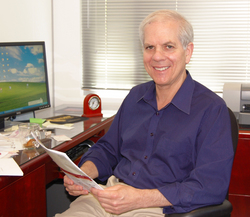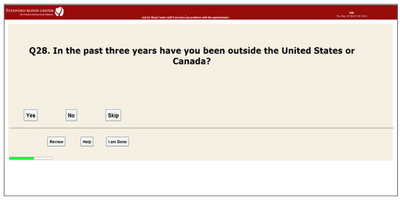About Blood Donation / FAQs

June 30, 2011 at 9:37 am
Published by Stanford Blood Center
On Dec. 29, 2010, Linda Johnson became the first woman to make 500 donations at Stanford Blood Center. It was more than 20 years ago when Linda's friend and Stanford Blood Center platelet donor, Stan Jensen, urged her to check if she would make a good platelet donor. Linda was a perfect candidate with good veins and a high platelet count.
June 24, 2011 at 2:48 pm
Published by Stanford Blood Center
By Ed Engleman, MD, Founder and Medical Director, Stanford Blood Center

During the early 1980s we decided to apply new research technology to a clinical problem: the prevention of the transmission by transfusion of Acquired Immune Deficiency Syndrome (AIDS). The problem was highly charged with social, political, legal, ethical, and economic overtones complicating the technical and medical issues at hand. In a decision that engendered intense controversy, in 1983 Stanford Blood Center instituted the first blood testing program specifically intended to reduce the risk of transfusion transmission of the then uncharacterized, but presumed infectious cause of AIDS.
June 7, 2011 at 1:30 pm
Published by Stanford Blood Center
By Julie Ruel, Social Media Manager, Stanford Blood Center

One common question we hear from blood donors is, "Why do I need to answer the same questions each time I come in to give blood? Can't you keep my responses on file?" We cannot and here's why. The Food and Drug Administration (FDA) requires that all blood centers ask all blood donors all questions on the day of each blood donation as a safety measure. Honesty and consistency in answering these questions is critical. The safety of the blood supply and the patients receiving the blood depend on truthful answers.
June 1, 2011 at 11:05 am
Published by Stanford Blood Center
It was December 1944 and a young journalist for the Call-Bulletin in San Francisco had an idea; one that would earn him a Pulitzer Prize for reporting. Jack McDowell, like so many other young men living in a time of war, volunteered to go fight for his country. His poor eyesight kept him out but it was ultimately his vision for this series of articles that won him the prestigious prize.
May 6, 2011 at 2:46 pm
Published by Stanford Blood Center
Tweet By John Williams, Marketing Manager, Stanford Blood Center Every day in the news we are bombarded with images of conflict, disaster, and crime. We are constantly reminded of the differences between people, especially race, ideology, or nation state. Pro...
April 22, 2011 at 11:38 am
Published by Stanford Blood Center
Tweet By John Williams, Marketing Manager, Stanford Blood Center Isn’t the earth an amazing place? We abuse it every day and it still forgives us. I think we often fail to see it as a living organism. Flora and fauna...
April 7, 2011 at 8:00 am
Published by Stanford Blood Center
By Julie Ruel, Social Media Manager, Stanford Blood Center In speaking with Dr. Sean Owens about the transfusion department he heads at UC Davis, I found they have a similar blood donation operation to Stanford Blood Center. They go to...

March 23, 2011 at 12:00 pm
Published by Stanford Blood Center
The following piece by blood donor Kathy Harris is something she voluntarily wrote following her very first blood donation. Please be sure to share it with your friends who are not yet blood donors as a bit of encouragement to...
February 14, 2011 at 9:33 am
Published by Stanford Blood Center
Tweet By Donors & Friends of SBC We asked for your best Valentine’s Day haikus… And that we received! What a great compilation. Blood donors are sweet 🙂 Thankfully, your submissions are much better than that! Here they are, in...
November 5, 2010 at 1:58 pm
Published by Stanford Blood Center
By Billie Rubin, Hemoglobin’s Catabolic Cousin, reporting from the labs of Stanford Blood Center Most of our blood donors probably already know that the positive or negative after their blood type (A+, B-, for example) represents their Rh factor, an...



